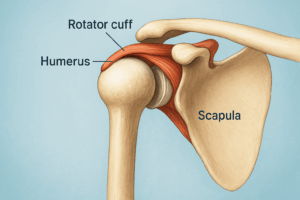
Shoulder joint anatomy – humerus, scapula, and rotator cuff”

“Shoulder joint anatomy – humerus, scapula, and rotator cuff”
TL;DR: Your shoulder is like a small “golf ball on a tee”; the humeral head touches only about one quarter of the glenoid fossa, giving great range of motion but little stability【815711575499601†L502-L518】. Understanding this design explains why the joint is so vulnerable and how acupuncture and gentle care can help it heal.
Key Takeaways
- The shoulder’s ball‑and‑socket design allows wide movement but sacrifices stability【815711575499601†L502-L518】.
- Stability comes from the rotator cuff muscles, capsule and labrum【815711575499601†L327-L332】.
- Poor posture, overuse, weak stabilizers and stress can lead to pain and inflammation.
- Acupuncture enhances circulation, reduces inflammation and relaxes tight muscles.
What It Is / How It Works
The glenohumeral joint is where the round humeral head sits in the shallow glenoid fossa of the scapula. Only about a quarter of the humeral head contacts the socket, making the joint as unstable as a golf ball on a tee【815711575499601†L502-L518】. Stability is provided by the rotator cuff muscles, capsular ligaments, coracohumeral ligament, the long head of the biceps, and the fibro‑cartilaginous labrum【815711575499601†L327-L332】.
Why It Hurts Easily
Because the joint is so mobile, it is prone to injuries and overuse. Common causes of shoulder pain include:
- Poor posture: slouching or rounded shoulders compress the joint.
- Repetitive overhead movement: activities like painting or throwing inflame the bursa and rotator cuff.
- Weak stabilizers: when rotator cuff muscles fatigue, larger muscles compensate and jam the joint.
- Stress and tension: tight neck and upper back muscles pull on the shoulder complex.
How Acupuncture Helps
Acupuncture improves blood flow to the shoulder, reduces inflammation and modulates the nervous system so that tight muscles relax. Many patients notice less pain and more mobility within a few sessions. A treatment plan may also include heat therapy, cupping and gentle stretching to restore balance.
Self‑Care Tips
- Apply a warm compress for 10–15 minutes daily.
- Do gentle pendulum swings to maintain movement.
- Avoid heavy lifting or repetitive overhead work until the pain subsides.
- If pain persists for more than two weeks, seek evaluation and consider acupuncture.
Written and clinically reviewed by NY PAPA Acupuncture & Herbal Medicine | Hicksville, NY.